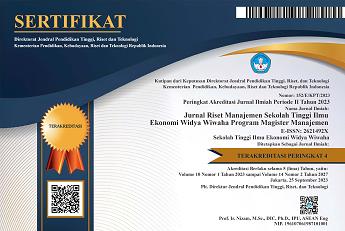POSISI POLITIK KOMISI PEMBERANTASAN KORUPSI ANALISIS PEMANGKU KEPENTINGAN PADA ORGANISASI PUBLIK
DOI:
https://doi.org/10.32477/jrm.v3i1.78Keywords:
public sector, stakeholders, political position, and proposed strategyAbstract
This paper attempts to find the political position of Komisi Pemberantasan Korupsi (The Corruption Eradication Commission) in the year of 2014. In so doing, it tries to use the stakeholders perspective as its theoretical framework which applied in public sector context. Stakeholders analysis is basically a political dimension of management. First, it shortly expouses what is meant by the stakeholders perspective. It is followed by an explanation about its mode of analysis and its strategic implication. Core of the paper is found where it explains the political position of Komisi Pemberantasan Korupsi (KPK) in its final part which includes a set of proposed strategy.
References
Agle, Bradley R. dan Ronald K. Mitchell (2008), Introduction: Recent Research and New Questions, Business Ethic Quarterly, Vol. 18, Issue 2: 153-9.
Agle, Bradley R. dan Ronald K. Mitchell (2008), Conclusion: Fom Dreaming to Actualization in Stakeholder Theory Development, Business Ethic Quarterly, Vol. 18, Issue 2: 181-90.
Agle, Bradley R., Ronald K. Mitchell, dan Jeffrey A. Sonnenfeld (1999), Who Matters to CEOs? An Investigation of Stakeholder Attribute and Salience, Corporate Performance, and CEO Values, Academy of Management Journal, Vol. 42, No. 5: 507- 25.
Benington, John dan Mark H. Moore ( 2011), Public Value in Complex and Changing Times dalam Public Value, Theory and Practice diedit oleh John Benington dan Mark H. Moore, hal 1-30. New York: Palgrave Macmillan.
Bingham, Lisa Blomgren, Tina Nabatchi, dan Rosemary O’Leary (2005), The New Governance: Practices and Processes for Stakeholder and Citizen Participation in the Work of Government, Public Administration Review, Vol.” 65, No.” 5: 547-58.
Brugha, Ruari dan Zsuzsa Varvasovszky (2000), Stakeholder Analysis: A Review, Health Policy and Planning, Vol. 15, No. 3: 229- 46.
Bryson, John M. (2004), Strategic Planning for Public and Nonprofit Organizations, A Guide to Strengthening and Sustaining Organizational Achievement, San Fransisco: Joseey-Bass.
Bryson, John M. (2003), What to Do When Stakeholder Matter, A Guide to Stakeholder Identification and Analysis Techniques, Washington, D.C.: Kertas kerja disampaikan pada National Public Management Conference, Georgetown University Public Policy Institute.
Bryson, John M. (2002), What To Do When Stakeholders Matter: The Case of Problem Formulation for the African-American Men Project of Hennepin County, Ann Arbor: Kertas kerja disampaikan pada the ICOS Seminar, University of Michigan.
Bryson, John M. (1995), Strategic Planning for Public and Nonprofit Organizations, A Guide to Strengthening and Sustaning Organizational Achievement, San Fransisco: Joseey-Bass Publishers.
Crosby, Benjamin L. (1991), Stakeholder Analysis: A Vital Tool for Strategic Managers, A publication of USAID’s Implementing Policy Change Project: Technical Notes.
Darnall, Nicole dan G. Jason Jolley (2004), Involving the Public: When Are Surveys and Stakeholder Interview Effective? Review of Policy Research, Vol. 21, No.4: 581-93.
Donaldson, Thomas dan Lee E. Preston (1995), The Stakeholder Theory of the Corporation: Concepts, Evidence, and Implications dalam the Academy of Mangement of Review, Vol. 20, No. 1: 65-91.
Freeman, R. Edward, Jeffrey S. Harrison, Andrew C. Wicks, Bidhan L. Parmar, Simone de Colle (2010), Stakeholder Theory, the State of the Art. Cambridge: Cambridge University Press.
Freeman, R. Edward (2004), The Stakeholder Approach Revisited. Charlottesville: Kertas kerja disampaikan di The Darden School of Management, Univerity of Virginia.
Freeman, R. Edward (1984), Strategic Management, A Stakeholder Approach, Boston: Pitman.
Freeman, R. Edward dan John Mc Vea. Akan Terbit. A Stakeholder Approach to Strategic Management dalam Handbook of Strategic Management diedit oleh M. Hitt, E. Freeman, dan J. Harrison. Blckwell Publishing.
Frenklin, Aimee L. dan Carol Ebdon (2002), Citizen Participation: Looks Good on Paper but Hard To Do in Practice, Kertas kerja disiapkan untuk ABFM Conference.
Frooman, Jeff (1999), Stakeholder Influence Strategies. The Acadamey Management Review, Vol. 24, No.2: 191-205.
Hansen, Ursula, Matthias Bode, dan Dirk Moosmayer (2004), Stakeholder Theory between General and Contextual Approach – A German View. Hannover: Kertas kerja disampaikan di Univeritat Hannover.
Johnson, Gerry dan Kevan Scholes (1993), Exploring Corporate Strategy, New York: Prentice Hall.
Martin, Steve (2009), Engaging with Citizens and Other Stakeholders dalam Public Management and Governance diedit oleh Tony Bovaird dan Elke Loffer, hal.: 279-96. New York: Routledge.
Mitchell, Ronald K., Bradley R. Agle, dan Donna J. Wood (1997), Toward a Theory of Stakeholder Adentifcation and Salience: Defining the Principle of Who and What Really Counts, The Academy of Management Review, Vol. 22, No. 4: 853-86.
Moore, Mark H. (1995), Creating Public Values, Strategic Management in Government, Cambridge: Harvard University Press.
Nutt, Paul C. dan Robert Backoff (1992), Strategic Management of Public and Third Sector Organizations, San Farnsisco: Jossey- Bass Publishers.
Pfeffer, Jeffrey dan Gerald R. Salancik (1978), The External Control of Organization, A Resource Dependence Perspective, New York: Harper & Row, Publishers.
Perrott, Bruce E. (1996), Managing Strategic Issues in the Public Serrvice, Long Range Planning, Vol. 29, No. 3: 337-45.
Rainey, Hal G. (2009), Understanding and Managing Public Organizations. San Fransisco: Jossey-Bass.
Savage, Grant T., Timothy W. Nix, Carlton J. Whitehead, dan John D. Blair (1991), Strategies for Assessing and Managing Organizational Stakeholders, The Academy of Management Review, Vol. 5, No. 2: 61- 75.
Schemeer, Kammi (1999), Guidelines for Conducting a Stakeholder Analysis, Bethesda: Partnerships for Helath Reform, Abt Associates Inc.
Scholes, Kevan (1998), Stakeholder Mapping: A Practical Tool for Managers dalam Exploring Techniques of Analysis and Evaluation in Stategic Management oleh Veronique Ambrosini dengan Gerry Johnson dan Kevan Scholes, hal.: 152-68. London: Prentice Hall Europe.
Varvasovszky, Zsuzsa dan Ruari Brugha (2000), How to Do (or Not to Do)…. A Stakeholder Analysis, Health Policy and Planning, Vol. 15, No. 3: 338-45.









